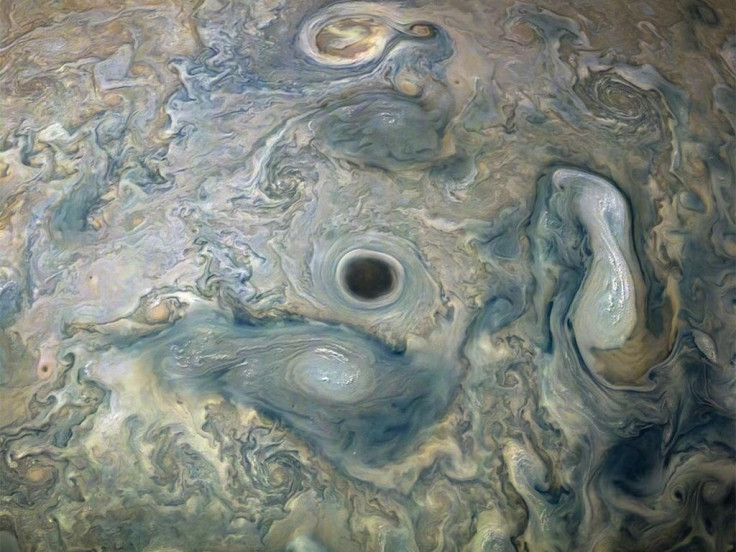NASA's Juno Mission Sheds Light On Jupiter Water Mystery Opened By Galileo Probe
KEY POINTS
- The 1995 Galileo probe resulted in 'inconclusive' data about water on Jupiter
- The new Juno mission aims to obtain water readings across large sections of Jupiter
- Based on Juno data, at Jupiter's equator, water makes up 0.25 percent of the atmosphere
- This counter's Galileo findings, which suggested that Jupiter is much drier than the Sun
NASA’s Galileo probe was the first spacecraft to orbit an outer planet and also the first one to deploy an entry probe into a planet’s atmosphere. It orbited Jupiter for eight years and its 1995 mission opened up a mystery about water on the planet.
In a new study, researchers used data from NASA’s Juno mission to shed light on Jupiter’s water mystery.
Jupiter’s Water Mystery
In 1995, the Galileo probe stopped transmitting just 57 minutes into its Jovian descent after being crushed by overwhelming pressure. However, the data that it was able to transmit during those 57 minutes suggested that Jupiter might be extremely dry compared to the Sun. This dismayed the scientists working on the data because the water on Jupiter appeared to be 10 times less than they had expected.
Furthermore, the water appeared to be increasing even at the greatest depth that was measured, which is already far below the depths where theories suggest that the atmosphere should have been well mixed. If the atmosphere was well mixed, the data that the probe gathered should have been a global average of the water on Jupiter but, an infrared map gathered at the same time showed that the probe mission could have been unlucky in that it so happened to have sampled a particularly dry and warm meteorological spot on the planet.
Therefore, the findings from the Galileo probe were inconclusive.
Having such an estimate of the water on Jupiter’s atmosphere is actually vital to understanding the formation of our solar system, particularly because Jupiter was likely the first planet that was formed and it contains most of the gas and dust that was not incorporated into the Sun.
Enter The Juno Mission
In 2011, NASA launched the Juno mission with the goal of obtaining water abundance readings from large regions of Jupiter. For this mission, Juno’s Microwave Radiometer instrument takes advantage of the scientific fact that water absorbs certain wavelengths of radiation.
In a new study published in Nature Astronomy, a Juno science team used the data from the Juno’s first eight flybys, focusing particularly on the gas giant’s equatorial region where the atmosphere appears to be more well-mixed.
Interestingly, the researchers found that in Jupiter’s equator, water makes up about 0.25 percent of the molecules in the atmosphere, which is three times more than that of the Sun. This first measurement of water on Jupiter is the first since the 1995 Galileo mission, which suggested that Jupiter was extremely dry compared to the Sun.
“We found the water in the equator to be greater than what the Galileo probe measured,” Juno scientist Cheng Li said. “Because the equatorial region is very unique at Jupiter, we need to compare these results with how much water is in other regions.”
It is worth noting that the comparison between the water on Jupiter and on the Sun is based on the presence of the components of water -oxygen and hydrogen- and not on liquid water.
“Just when we think we have things figured out, Jupiter reminds us how much we still have to learn,” Juno principal investigator Scott Bolton said. “Juno's surprise discovery that the atmosphere was not well mixed even well below the cloud tops is a puzzle that we are still trying to figure out. No one would have guessed that water might be so variable across the planet.”
Now, Juno's orbit is slowly moving northward as planned, which means it would bring Jupiter's northern hemisphere, including its water content, into sharper focus with every flyby.
The latest flyby of Jupiter occurred just this past Feb. 17. The next will be on April 10, 2020.

© Copyright IBTimes 2025. All rights reserved.






















